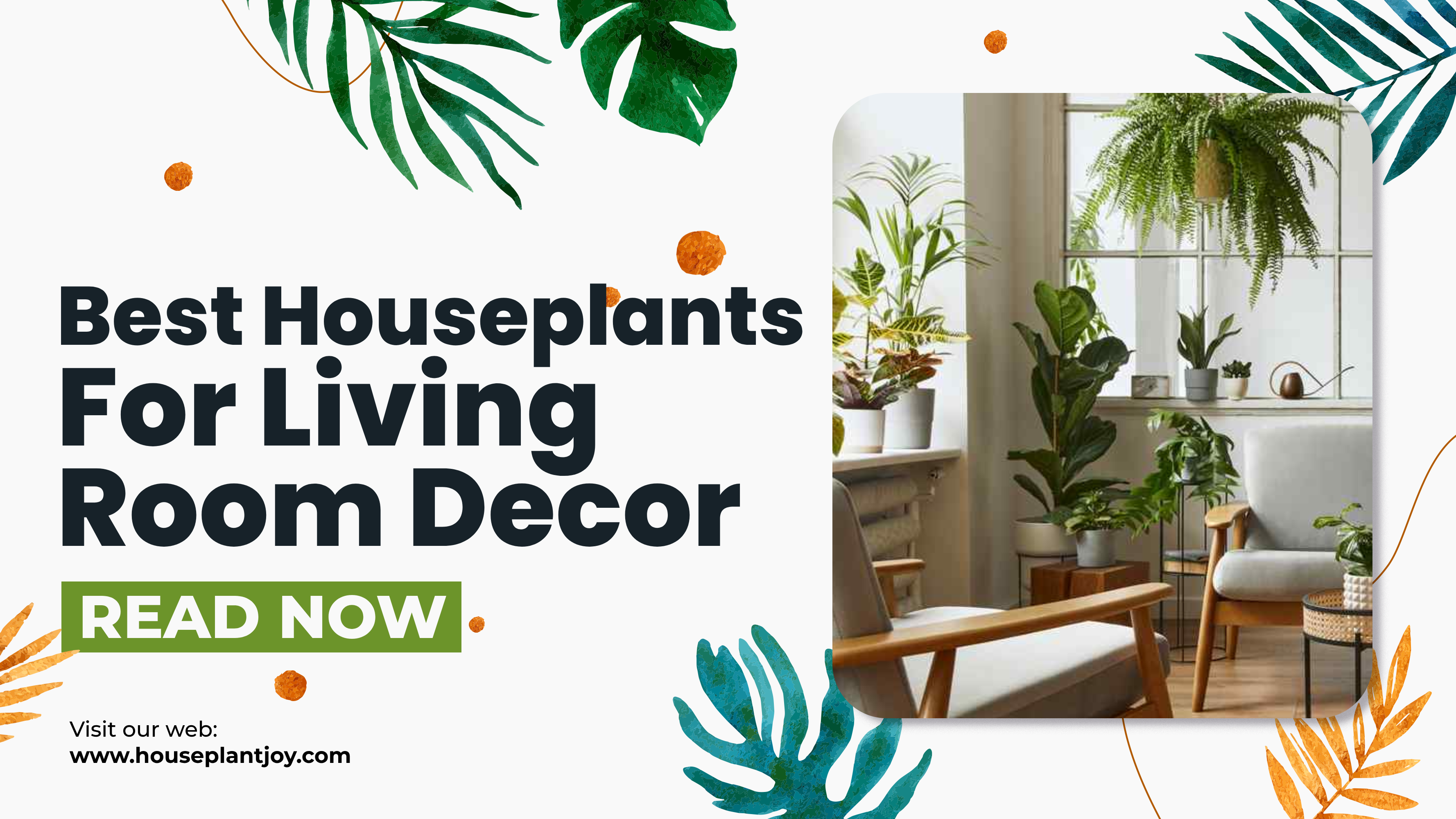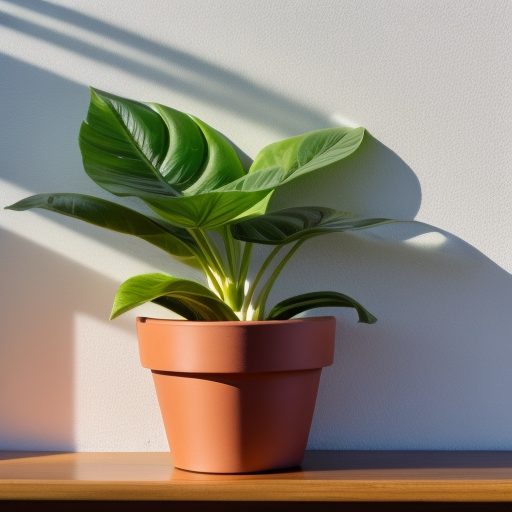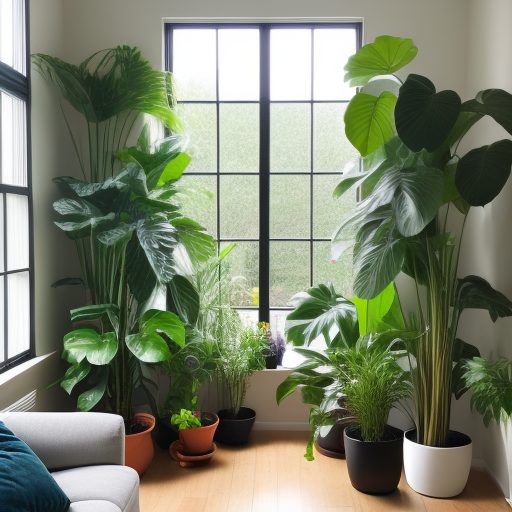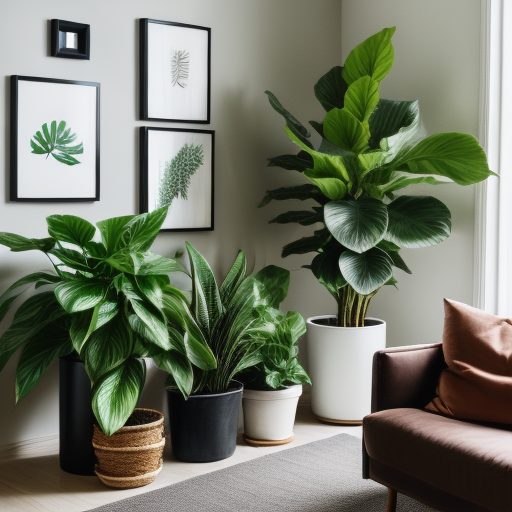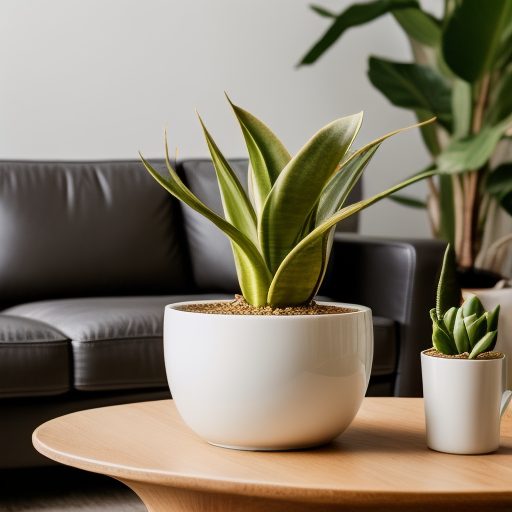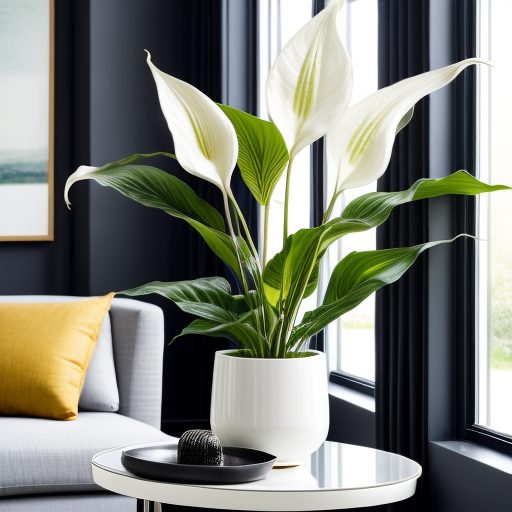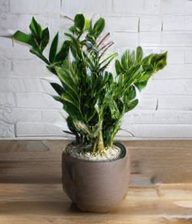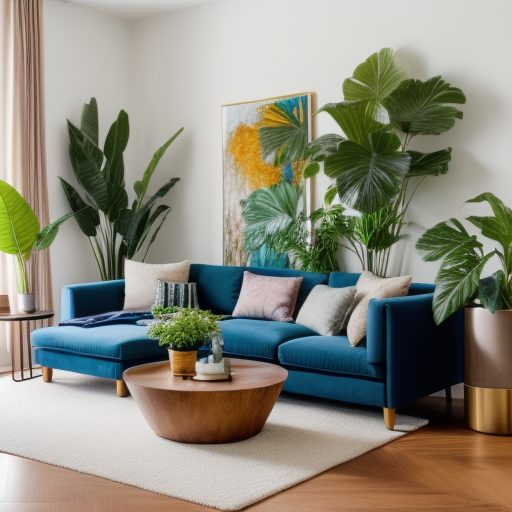HousePlantJoy is supported by our audience. When you purchase through one of our links, we may earn a small affiliate commission. As an Amazon Associate I earn from qualifying purchases. Your cost is not affected.
==================
Are you looking for a way to spruce up your living room decor? Consider adding some houseplants to your living room decor! Not only do they add a touch of nature and beauty to your space, but they also have numerous benefits. Houseplants can improve indoor air quality, reduce stress, and enhance mood.
Choosing the perfect houseplant for your living room may seem daunting, but it can be easy with some guidance. This post discusses the benefits of using houseplants in your living room decor and how to choose the perfect plant based on your living room’s environment.
We also give an overview of the best houseplants for living room decor that are easy to care for and visually appealing.
Lastly, we provide some tips on maintaining your houseplants so that they thrive in their new home.
Houseplants in living rooms create a natural and calming ambiance, making them a great addition to the décor. They bring a touch of greenery and life to the space, and indoor plants also improve air quality by filtering harmful toxins. Houseplants transform your living room into a peaceful retreat with their relaxing atmosphere and connection with nature.
Whether it’s the Swiss cheese plant, bird of paradise, or heartleaf philodendron, incorporating these plants in your living room design is a good choice for aesthetics and improved air quality.
Improvement in Indoor Air Quality
Houseplants in living room decor can significantly improve indoor air quality. Certain indoor plants, such as the Swiss cheese plant, bird of paradise, and heartleaf philodendron, can remove toxins from the air, acting as natural air purifiers.
These living room plants contribute to cleaner and healthier indoor environments by filtering air pollutants. Incorporating houseplants like the ficus elastica, kentia palm, and Chinese evergreen can reduce indoor air pollution and create a more refreshing atmosphere.
With their striking addition to interior design, these best indoor plants not only enhance the aesthetic appeal but also provide the benefit of improved air quality.
Enhancing the Aesthetic Appeal of the Living Room
Adding houseplants to the living room enhances the aesthetic appeal and creates a natural and inviting atmosphere. These indoor plants serve as focal points in living room decor, adding visual interest, texture, and a pop of color.
Houseplants can bring life and freshness to any living room, whether it’s the striking leaves of the Swiss cheese plant or the vibrant blooms of the bird of paradise. You can create a visually stunning and deep space by incorporating plants into your living room design.
Choosing the Perfect Houseplant for Your Living Room
When selecting houseplants for your living room, it’s essential to consider the lighting and temperature in the space. Please look for indoor plants that thrive in low light conditions, such as the Swiss cheese plant or bird of paradise. These plants add a touch of greenery even if your living room doesn’t receive much direct sunlight.
Additionally, choose houseplants that are low-maintenance and easy to care for, like the heartleaf philodendron or ficus elastica. If you have limited space, opt for smaller plants that will be manageable for your living room.
Lastly, consider the houseplants’ size and growth habits to ensure they fit well in your living room design. Considering these factors, you can find the perfect houseplant for your living room decor without hassle.
Understanding Your Living Room’s Environment
Understanding your living room’s environment is essential to creating the perfect oasis with houseplants. Start by determining the natural light levels in the room.
Bright light-loving plants like the Swiss cheese plant and Bird of Paradise are an excellent choice for spaces with indirect sunlight. Next, please look at the humidity level in your living room—plants like the heartleaf philodendron and ficus elastica thrive in moderately humid environments.
Consider the temperature fluctuations in your living room and choose plants accordingly. Analyze the air circulation in the space, as some plants prefer good airflow, like the Kentia palm. Lastly, evaluate the available area to determine suitable plant sizes.
Understanding your living room’s environment allows you to select the best indoor plants for a stunning and thriving display.
Selecting a Plant-Based on Light and Space Availability
When choosing houseplants for your living room, it’s essential to consider the availability of light and space. Opt for indoor plants that thrive in bright, indirect light conditions, such as the Swiss cheese plant or the bird of paradise.
If you have a low-light living room environment, consider the heartleaf philodendron or the ficus elastica. Choose plants with compact growth habits for small living room spaces, like the Kentia palm or the money plant. Consider the lighting situation in your living room and select plants that can tolerate direct sunlight exposure.
By selecting the right plants based on light and space availability, you can create a striking addition to your living room decor.
Revitalize your living room decor effortlessly with a chic hanging planter that marries style and functionality seamlessly. Elevate your space with a touch of greenery suspended in modern elegance! #ads #commissionsearned
Overview of Best Houseplants for Living Room Decor
The living room is the heart of the home, and incorporating houseplants into the decor can bring life and vibrancy to the space.
When choosing the best houseplants for your living room, several options exist. The resilient snake plant is an excellent choice. It can thrive in various lighting situations, including bright and indirect sunlight. Pothos, with its trailing vines, adds versatility to living room design and can be displayed in hanging baskets or on shelves.
Another striking addition to the living room decor is the exquisite peace lily. It’s known for both its beauty and air-purifying qualities. Spider plants are also a popular choice. They are low-light tolerant and thrive in a living room’s typically moderate lighting situation.
Snake plants, peace lilies, and pothos are popular indoor plants that can enhance the aesthetic appeal of any living room.
Snake Plant
With its striking leaves, the resilient snake plant is an ideal choice for living room decor. Its dark green, glossy foliage adds a touch of elegance to the overall design. This houseplant is perfect for living rooms with indirect light, as it is low light tolerant.
Additionally, snake plants are known for their low-maintenance nature. This makes them an excellent option for busy living room plant parents. Not only that, but the snake plant also contributes to a healthier living room environment with its air-purifying qualities.
Pothos
With its heart-shaped leaves, Pothos is a popular choice for living room plants. It is an excellent option for living room shelves, coffee tables, or end tables, adding a whimsical and natural feel.
Pothos plants are known for their low light tolerance, making them suitable for living room corners with indirect sunlight. Their trailing vines create a striking addition to any living room decor.
Another advantage of pothos plants is that they are low-maintenance, requiring regular watering and moist soil for best results.
Peace Lily
Peace lilies, glossy leaves, and striking white flowers are a unique addition to any living room. These houseplants are a good choice for plant parents looking to add a touch of elegance and color to their living space.
The peace lily’s air-purifying qualities make it an excellent option for improving indoor air quality. With their shade-tolerant nature, peace lilies thrive in low-light living rooms, making them ideal for any lighting situation.
Additionally, peace lilies are low-maintenance plants, perfect for beginners or those with a busy schedule.
The ZZ Plant
With its dark green, shiny leaves, and unique geometric shape, the ZZ plant (Zamioculcas zamiifolia) brings a touch of modern elegance to any living room. This low-maintenance plant can thrive in low-light conditions and requires infrequent watering.
The ZZ plant adds beauty to your space and purifies the air, making it an excellent choice for improving indoor air quality. It’s also pet-friendly and capable of growing up to 3 feet tall. The ZZ plant is a striking addition to larger living rooms.
Tips on Maintaining Your Living Room Houseplants
There are a few tips to remember when maintaining your living room houseplants. If your living room doesn’t get much natural light, choose houseplants that thrive in low-light conditions, like the Swiss cheese plant or bird of paradise.
Regularly watering your plants is essential, but please be careful not to overwater them. Using fertilizer can help your plants grow and stay healthy. Keep an eye out for pests and diseases that could harm your plants, and consider repotting them if they outgrow their current containers.
Regular Watering and Fertilizing Guidelines
To ensure the health and vitality of your houseplants, it’s important to follow regular watering and fertilizing guidelines. Water your plants when the top inch of soil feels dry. This indicates that they need hydration. However, be cautious not to overwater them, which can lead to root rot and other plant health issues.
Additionally, nourish your plants every 4-6 weeks with a well-balanced liquid fertilizer to provide the necessary nutrients. Remember to adjust the watering frequency and amount based on the specific needs of each plant and the environmental conditions. Following these guidelines will help your houseplants thrive and beautify your living room.
Ideal Temperature and Humidity Conditions
Most houseplants prefer temperatures between 65-75 degrees Fahrenheit for optimal growth. However, certain plants, like ferns, thrive in higher humidity levels. To increase humidity, you can use a room humidifier or mist your plants regularly.
It’s essential to avoid placing houseplants in drafty areas or near air conditioning vents, as this can lead to temperature fluctuations. Maintaining consistent temperature and humidity levels will provide the ideal conditions for healthy growth and vibrant living room plants.
Elevate your living room’s aesthetic with the ideal planter – a harmonious blend of chic design and plant-friendly functionality. Level up your decor game effortlessly! #ads #commissionsearned
Can Houseplants Help Reduce Stress and Enhance Mood?
Houseplants have been shown to reduce stress and improve mood. Their green foliage creates a calming effect, promoting tranquility in the living room. Caring for plants can be therapeutic, providing a sense of purpose and accomplishment.
Houseplants act as natural air purifiers, creating a healthier indoor environment that positively impacts overall well-being. Incorporating houseplants in your living room decor can create a peaceful and uplifting atmosphere, helping to reduce stress levels.
Ready For a Living Room with Houseplants?
Houseplants enhance the aesthetic appeal of your living room and provide numerous benefits for your overall well-being. They improve indoor air quality by filtering toxins and releasing oxygen, creating a healthier environment.
When choosing the perfect houseplant, consider your living room’s environment, available light, and space. Some popular options for living room decor include the resilient Snake Plant, the versatile Pothos, the exquisite Peace Lily, and the vibrant ZZ Plant.
To maintain your houseplants, follow regular watering and fertilizing guidelines and ensure ideal temperature and humidity conditions. Moreover, studies have shown that houseplants can help reduce stress and enhance mood, making them an excellent addition to your living room. So why wait? Bring nature indoors and enjoy the benefits of houseplants today.
Frequently Asked Questions
What are some low-maintenance houseplants that are ideal for living room decor?
So, you’re looking for low-maintenance houseplants to add to your living room decor. Consider the resilient snake plant, which can survive in low light. The versatile ZZ plant thrives in different lighting conditions. Pothos is a trailing plant perfect for hanging baskets or climbing walls. Spider plants are air-purifying and grow well in bright, indirect light.
How can I incorporate plants into my living room design without overwhelming the space?
Incorporating plants into your living room design without overwhelming the space is all about balance. Choose plants that match the size and style of your living room. Please place them in areas with natural light, but avoid overcrowding. Elevate plants with stands or hanging pots for visual interest and add depth by incorporating plants with different textures and colors.
What are some benefits of having plants besides their aesthetic value in the home?
Plants in the home offer more than just aesthetic value. They improve indoor air quality by removing toxins and producing oxygen. Studies show that they can reduce stress and enhance mood. Certain plants, like lavender and chamomile, have calming properties that aid relaxation. Caring for plants also provides a sense of responsibility and routine, which benefits mental health.
Are there any plants that should be avoided due to potential allergies or pet toxicity?
Some houseplants can cause allergies or be toxic to pets. Examples of plants to avoid include lilies (toxic to cats), philodendrons (toxic to dogs and cats), and rubber plants (which can cause allergies). Safe options for pet-friendly houseplants include spider plants, African violets, and Boston ferns.
Always research the toxicity of any plant before bringing it into your home with pets.
Learn More About Houseplants!
Discover more types of houseplants, their benefits, and how to care for them with us! Join us on Facebook, Instagram, and Twitter for beautiful photos, plant care tips, and a community that celebrates the joy of indoor gardening.
Facebook: https://www.facebook.com/houseplantjoyblog
Instagram: http://instagram.com/houseplantjoy20
Twitter: https://twitter.com/HouseplantJoy
Let’s nurture our green spaces together!

